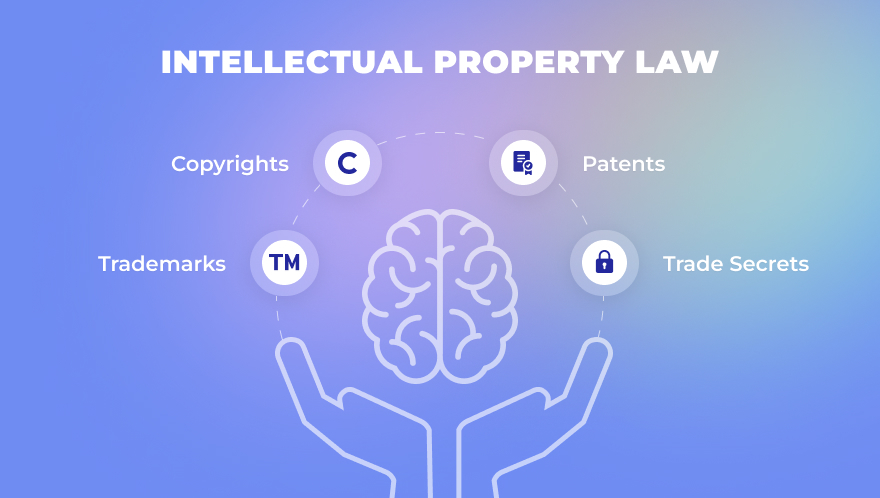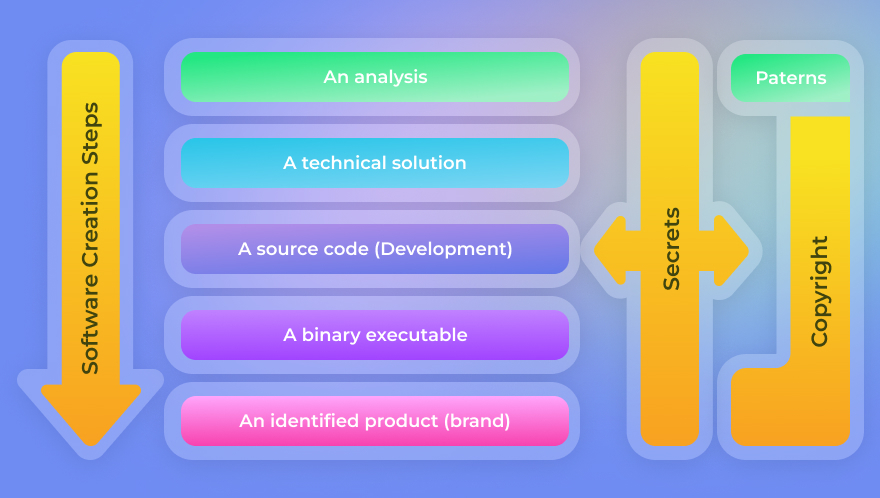How to Address Intellectual Property When Developing a Product
Being a start-up or spinoff owner, thinking about the future exit of your product or solution, you usually think in several streams. Your product needs to have a star team, sufficient funding, a great user experience, and a fancy business plan, and mainly you are focused on growing the user base which results in a higher valuation of your asset.
However, a lot of owners might neglect to protect software intellectual property which potentially could result in severe problems while sorting out the future possible exit of the start-up.
Being a software development company, you need to comply with the requirements of the clients, while keeping a balance between the expenses of the project, and its legal feasibility from the IP standpoint.
What is Intellectual Property?
Intellectual property includes all exclusive rights to intellectual creations. Basically, it is a set of laws and rules implemented for the legal protection of information and intellectual goods.
At its core, IP protection exists to stimulate human intellectual creativity. Intellectual property rights are essential for the growth of economics nowadays: innovations help countries develop and increase GDP more than anything. When there is adequate legislation and laws to ensure IP protection help to retain inventors inside the country.
The World Intellectual Property Organization, also known as WIPO, is a United Nations (UN) agency that works in the field of intellectual property protection and popularization.
Main Types of Intellectual Property

There are four types of intellectual property:
- trade secrets (the exclusive right to a process, tool, mechanism, or formula that is not publicly available and is kept secret by its owner to gain competitive advantage);
- patents (the exclusive right to produce, use, and sell an invention);
- copyrights (exclusive right to copy, modify, and distribute or sell copies or modifications of the property);
- trademarks (symbol, phrase, name, or another type of expression used to distinguish a particular product or brand).
Software Intellectual Property
Intellectual property rights for software are designed to protect your code or software itself from theft or unauthorized use. There are different approaches how to address software IP protection. Copyright and software patents are both possible options, as well as using trade secrets.
Companies might also create trademarks to protect the name and logo of the software program, however, they won’t be able to do anything regarding computer code protection.
What to Take into Consideration about Intellectual Property Rights?
Various Types of Contractual Arrangements
Development of any product is usually conducted by teams, which might be combined – partially consisting of internal employees of the company, freelancers/subcontractors, or even teams of developers provided by 3rd party vendors. It’s very important to understand contractual arrangements with all such types of vendors, each of them requires another approach.
In most jurisdictions, the simplest contractual arrangement is with the official employees based on the Labor Code of the respective country under which jurisdiction your company operates. Usually, all intellectual property ownership provided by employees belongs to the company, however authorship of the delivered artifacts remains on those particular employees, who provided the work.
The trickier situation arises when talking about work-relationship with subcontractors or freelancers. Those are usually private entrepreneurs sole proprietors who are providing their services based on charging fees per hour, man-days, or month. It’s very important to enter a proper contractual relationship with such suppliers, which covers all important arrangements about Intellectual Property ownership and might even cover eventual licensing of the delivered artifacts.
Risks with Vendors
Another tricky situation might arise when the business owner is contracting a vendor – usually an IT Service company that might provide dedicated teams or individual engineers working on a project under the T&M model.
In such a case, it’s important also to understand what kind of contractual relationship is on the side of the vendor and their employees or contractors. It’s expectable that the vendor is also subcontracting other sub-vendors or another freelancer which brings additional risk factors of unsettled Intellectual Property Ownership.
Usually, the MSA contract you as the business owner has with your IT service vendor should cover your IP ownership, but what if a situation arises that IP was not covered well on the side of the vendor?
This might potentially bring the whole product at risk, because particular sub-contractors working on the product may demand IP or legally might be even entitled to use the output of their work in competitive products for example. This doesn’t mean your vendor is not responsible for this situation, however, the entire product is at risk and the business owner needs to address this situation rapidly.
Defensive Rights
IP rights, when settled correctly, provide defensive rights, which a business owner might need in a case of legal involvement of 3rd party claiming or disputing the legal IP ownership.
In such a case, the well-covered IP part of your business might help not only to sleep better but mainly enables the defendant to construct its defense on a much more solid foundation.
Having unsettled or not correctly settled intellectual property of the product might result in unpredictable consequences of thinking about the settlement of IPs from the beginning making product development more mature.
Indemnify and Defend
Clearly stated indemnity provisions in the MSA could provide significant protection to the customer when it comes to potential third-party claims alleging IP infringement. Sometimes it happens that the customer delegates IP-protected product /solution development to the vendor, whereas the vendor may use some third-party IP and incorporates it into the product.
In this case, the customer is advised to have provisions in the MSA covering IP Indemnification against the third party claims so that it can seek legal protection and defense from the vendor once the IP rights of the third party are proved to be infringed.
In simple words, if the customer gets a claim from a third party stating that its IP was used in the customer’s product and IP rights of such third party were infringed and such claim arises at the vendors’ fault, the customer will have a right to recourse to the vendor either in full (meaning that the vendor will be obliged to take control over the legal case, organize legal defense and pay all legal expenses) or partially (whereas the vendor will join the customer in an effort to settle the claim and partially cover the legal expense).
Setting up a clear procedure of IP indemnification in the contractual arrangements should simplify the potential claim handling once the indemnification event occurs. Indemnity provisions are crucial as they state that one party will protect another party against the losses that could potentially arise from a third-party claim.
So, if done correctly, the indemnified party (the customer) could request the indemnitor (the vendor) to take control over the legal defense, pay for it (attorneys, legal fees, etc.), and cover the losses arising out of or related to the indemnified claim.
Intellectual Property in Product Development

Having clarity on IP topics is also important from the IT service vendor standpoint. It’s essential to educate technical decision-makers to take into consideration licenses of libraries, plugins, or whatever 3rd party systems which potentially might be involved within the resulting system because improper usage might result in violation of license agreements or breaching IP ownership of their respective owners.
Usually, this will not result in a practical problem, although problems may arise when the client requests written confirmation or settlement of IPs and the vendor suddenly understands that some parts of the developed product might not be fully compliant with the license arrangements of their sub-vendors.
In extreme cases, it might lead to significant financial losses, mainly when the license arrangement of some core subpart of the system doesn’t allow its reselling without keeping the source open. This usually isn’t the case with commercial software development.
Work for Hire – Why Should You Care
Work for hire is a commonly used concept in US copyright law and other jurisdictions. The concept basically states that the owner of copyrighted material should stay with a company even though it was developed by an individual employee of the company.
For instance, Windows and macOS have been developed by thousands of Microsoft and Apple employees, and thousands of patents were registered, but at the end of the day both operating systems are owned by Microsoft and Apple, as all those developments were made according to “work for hire” concept.
The same concept usually could be applied in the works completed by independent contractors, freelancers, and vendors. So to make it easier to protect customers’ ownership rights in the future, it is important to have “work for hire” provisions in the MSA, whereas the customer shall enjoy all and any proprietary rights in the works specially ordered and commissioned by the customer.
In common practice, and according to the copyright laws in many developed jurisdictions, the customer shall be considered as the owner of the software product, but often the author of the software product is someone who basically created it. Even though the author assigns ownership over such a product to the customer, he or she is still recognized as the author and has “moral rights”.
Therefore, it is important to explicitly state in the contractual arrangements with both employees, contractors, and vendors who will own the software product and secure the waiver from the author that he or she will not enforce their “moral rights” before they are being engaged in such works.
Do Not Steal the IP of Your Clients
Many software development companies tend to reuse their code, which is, of course, a wise commercial practice, however, it’s important to find the right balance between what is just reusing the previously developed components, and what already might be considered a breach of Intellectual Property ownership of the original client.
Software vendors tend to increase their revenue by reselling similar tools or solutions to other clients based on their previous experience with similar clients. Inevitably it can come down to ideas about reusing a whole part of the code developed for another client while violating its intellectual property for the sake of revenue.
Use the Intellectual Property as Your Future Revenue Stream
Think about your future. Software vendors might find a client looking for a complex software solution, which might be very easily resalable on the market in the future. Does it make sense for the software vendor to deliver this service to this client, or does it make more sense to arrange a partnership?
Sacrificing a part of the revenue for the sake of obtaining the Intellectual Property or a license for reselling might be a very effective way of increasing your leverage on the cooperation with this particular client.
In Conclusion
Intellectual Property ownership is a complex topic that must be covered from various standpoints – operational, legal, technical, or financial. Software development and product development is a hectic industry, where stakeholders occasionally tend to forget about legal points of view for the sake of velocity of delivery. This is pretty normal, and it’s ok until a problem arises.
At that time, solving potential IP leaks or issue related to them might be very expensive and difficult or even impossible to solve. It’s good to implement rules about IP problems mitigation or leverage IP topics to processes on the level of a whole company.
Cooperating with a reliable software vendor who knows how to work software intellectual property will decrease the chance of something going wrong with software IP.
Altamira, being on the market for more than a decade, knows how to handle intellectual property IP and how to prevent IP leaks. We enforce a confidentiality agreement, as well as sign non-disclosure agreements with our clients.






